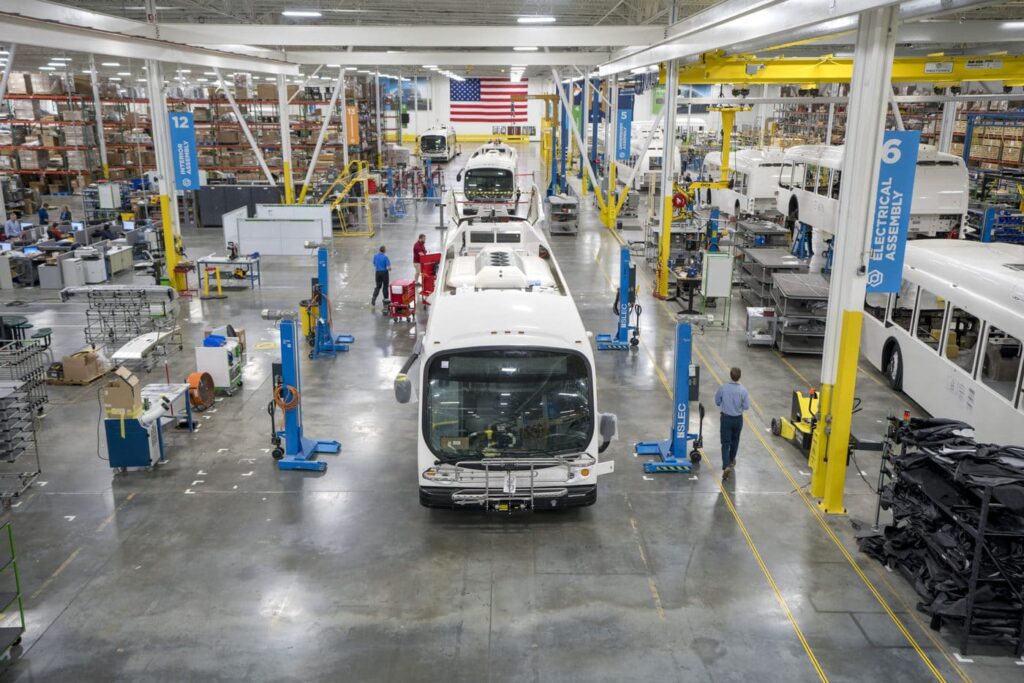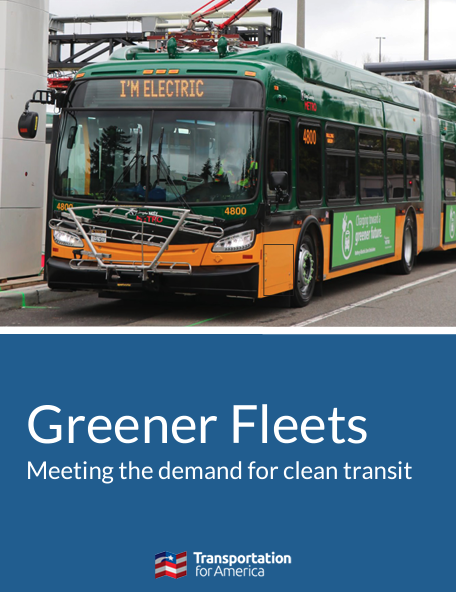
Greener Fleets: How federal dollars can supply the demand for clean transit


The Low and No Emission Vehicles (Low No) program saw a big increase in funding in America’s historic infrastructure law, but an outdated and arbitrary requirement is pushing transit agencies toward buses that still pollute. Here’s how Congress and the Federal Transit Administration can avoid locking in emissions for years to come.
While scientists have rung the alarms on climate change for decades, the 2021 infrastructure law is American policymakers’ first significant response. While unfortunately allowing for much climate-damaging investment in highway expansion, the IIJA also invests significantly in public transit systems including $5.5 billion over its five-year appropriation period for the Low or No Emission Vehicle (Low No) program—six times more than the program’s previous five years of funding. As the title suggests, the Low No program helps transit agencies transition their fleets to low- and zero-emission buses. Additionally, the IIJA provided nearly $2 billion in funding over five years for the closely-related Bus and Bus Facilities Program. While these programs are record-breaking for their level of investments in clean buses and supporting infrastructure, this legislation has flaws that are holding the nation back from cleaning up the bus fleet.
In October of 2022, Transportation for America filed a Freedom of Information Act (FOIA) request with the Federal Transit Administration (FTA) for a synthesis of all applications submitted to the Low No and Bus and Bus Facilities programs in fiscal year 2022 (FY22). We wanted to better understand how the programs are serving U.S. transit agencies’ needs and supporting America’s climate goals and emission reduction efforts. What we found was worrying.
As we wrote in Greener Fleets, a white paper we’ve submitted to Congressional leaders, we found that the program encourages transit agencies to buy diesel hybrid and compressed natural gas (CNG) buses instead of zero-emission buses running on electricity or hydrogen. The root cause: 25 percent of the Low No program’s funding is reserved for low-emission (as opposed to zero-emission) projects. This is artificially constraining the supply of zero-emission funds, locking in unnecessary transit emissions for decades.
Low No is coming up short
Applications for grants in FY22 for zero-emission projects of the Low No and Bus and Bus Facilities programs were in extremely high demand, composing 86 percent of the combined two programs’ grant requests.
The Bus and Bus Facilities program does not place constraints on fuel types when considering awards, focusing on the applicant’s project rating (Highly Recommended, Recommended, Not Recommended). Still, as shown in the graph below, zero-emission projects had a one in six chance of being awarded while consuming 83 percent of the program’s available funding.
The strong demand for zero-emission buses and facilities shows that transit agencies have gotten comfortable with relatively new electric and hydrogen bus products and are more ready than ever to invest in the zero-emission transition.
The Low No program is statutorily required to reserve 25 percent of available funds for projects using low-emission fuels, such as CNG, diesel-electric hybrid, and propane. In other words, even though 88 percent of applications were for no-emission buses and facilities, FTA was required to award 25 percent of the funding to more polluting low-emission projects. Due to this requirement, as shown in the graph above, nearly 100 percent of the low-emission projects received an award, while more than two-thirds of clean zero-emission applications were rejected. There weren’t even enough low-emission projects in the application pool to meet the 25 percent requirement.
We were concerned that this funding acceptance rate would encourage American transit agencies to give up competing for zero-emission funds (in extremely high demand), and instead apply for the less competitive low-emission funding. Based on early trends in FY23 applications, our concerns were justified. More transit agencies are competing for low-emission project funding than in FY22, putting them on track to deploy buses that will continue polluting for a decade or more, and slowing the development of an EV transit bus supply chain.
How did the 25 percent requirement come to be?
In 2015, the law that outlined the details of the Low or No Emission Vehicle program was passed by the U.S. Congress and Senate. Senator Toomey of Pennsylvania argued for a mandate to require funds be reserved for low-emission vehicles in the legislation. He successfully included a statutory requirement that 25 percent of the Low No program funding go to projects using low-emission fuels, such as CNG, a key product of Pennsylvania, whose natural gas production is second only to Texas. This statutory requirement to subsidize fossil fuels in an age of energy transition leads the IIJA to invest 1.4 billion over this 5 year authorization period in buses that still pollute.
Change the status quo
The Low No and the Bus and Bus Facilities programs are essential to ensuring American transit agencies can replace their aging bus fleets with low and zero-emission vehicles, and transit agencies are clearly eager to rise to the challenge. Congress can do more to ensure that these programs are working to accomplish emission reduction goals. They could start by eliminating the outdated and arbitrary requirement that 25 percent of Low No funding goes to low-emission vehicles. But they should go further: increasing funding for both programs to meet the overall demand for buses and facilities; creating incentives for both programs to leverage other funding sources; and increasing transparency of the program by making basic application and award information available on FTA’s website and looking for ways to simplify the application process.
Ultimately, Congress and FTA should work together to form a vision for how the Low No and Bus and Bus Facilities programs can support American transit agencies in providing excellent transit service in our communities and converting their operations to zero-emissions rapidly enough to meet greenhouse gas reduction goals and improve air quality in the communities they serve.

For more information on this problem and how to solve it, read Greener Fleets: Meeting the demand for cleaner transit.





